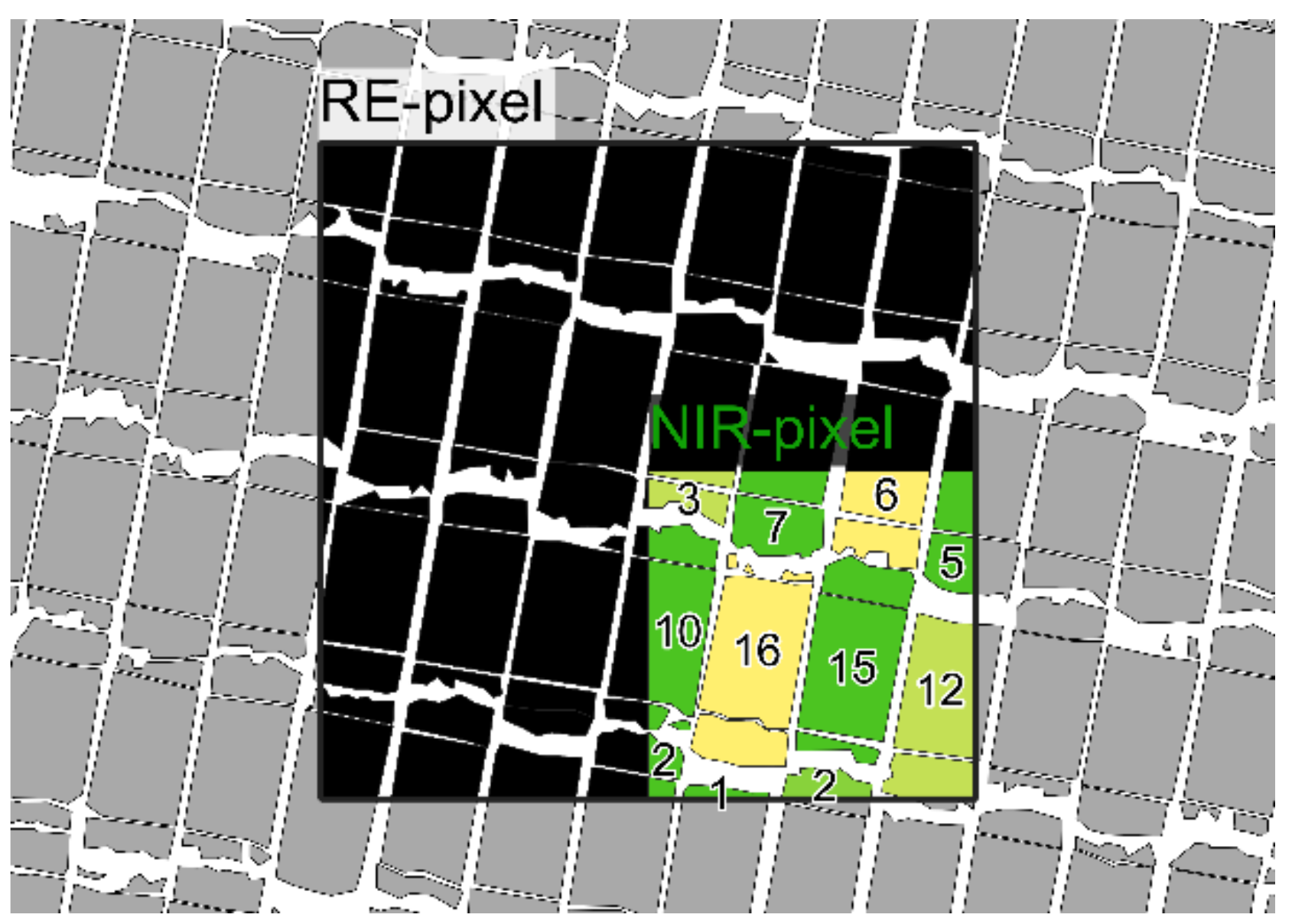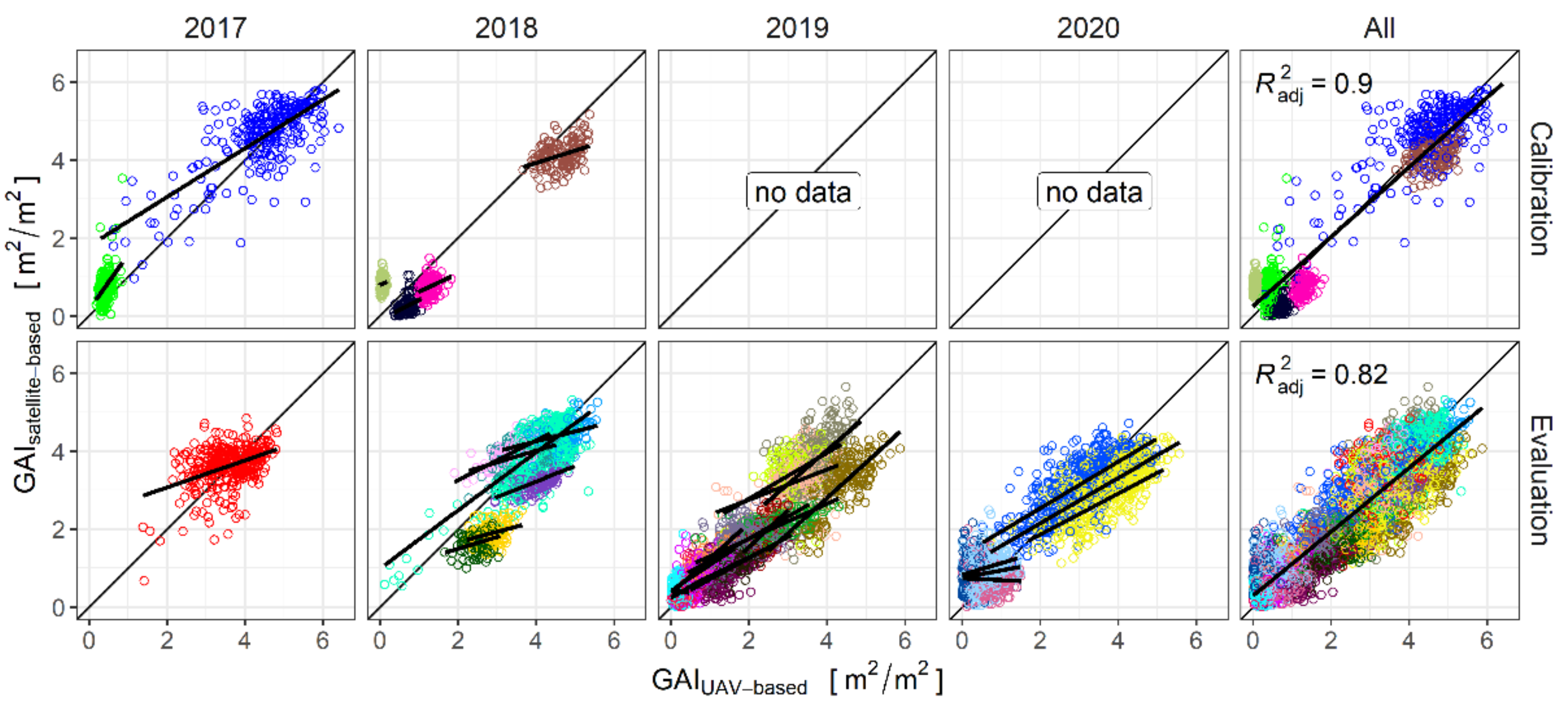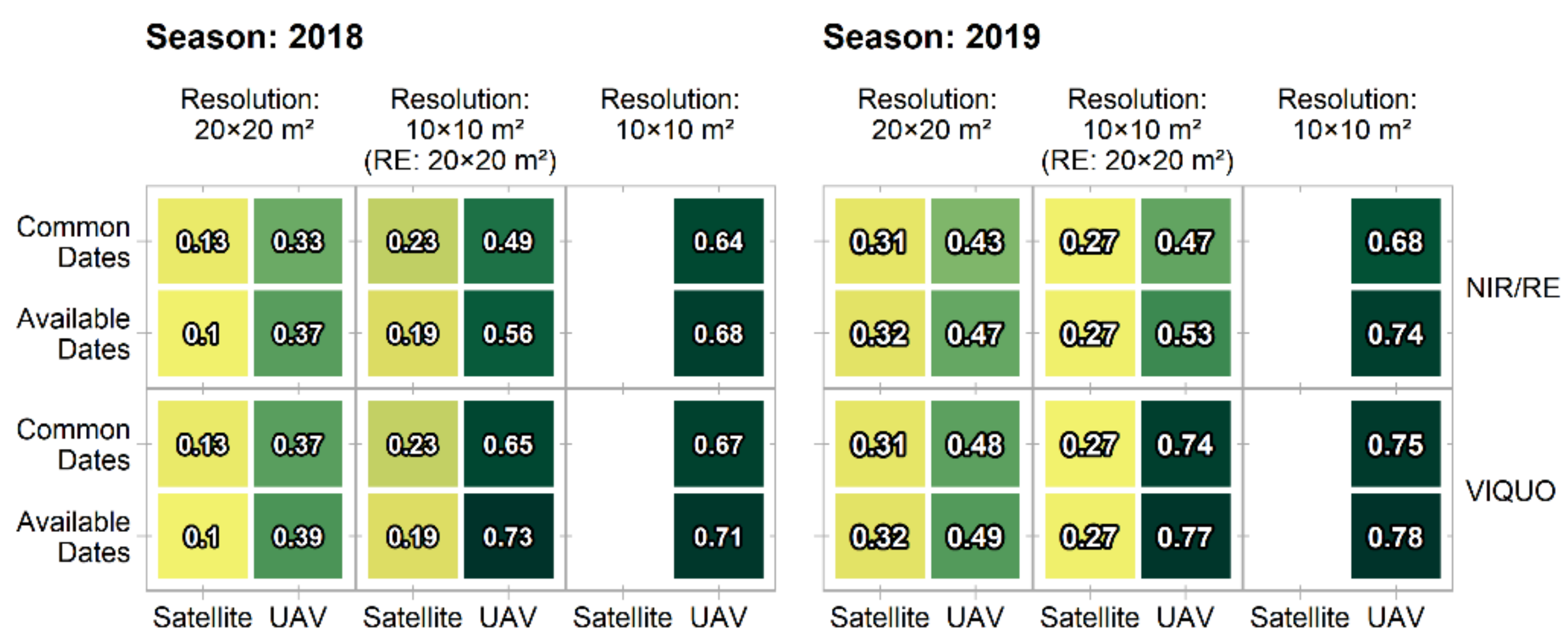Sentinel-2 Data for Precision Agriculture?—A UAV-Based Assessment
Abstract
1. Introduction
2. Materials and Methods
2.1. Data Acquisition
2.1.1. Study Sites
2.1.2. UAV-Based Multispectral Data
2.1.3. Satellite-Based Multispectral Data
2.1.4. Ground Truth Data
2.2. Statistical Analysis
2.2.1. GAI-Model for Sentinel-2 Multispectral Data
2.2.2. Application of Satellite and UAV Data for Crop Monitoring
3. Results
3.1. Sentinel-2 GAI-Predictions: Overall Calibration
3.2. Application of Satellite and UAV Data for Crop Monitoring
4. Discussion
4.1. Concept of UAV-based Calibration and Evaluation of Satellite Data
4.2. Accuracy of the GAI-Prediction
4.3. Spatial and Temporal Resolution of Sentinel-2 GAI-Predictions
4.3.1. Spatial Resolution
4.3.2. Temporal Resolution
4.4. Application of Satellite and UAV Data for Crop Monitoring
5. Conclusions
Author Contributions
Funding
Data Availability Statement
Conflicts of Interest
Appendix A

| Sentinel-2 Date | UAV Date | Number of Area Sections (Number of Grid Elements, Size = 10 × 10 m2) |
|---|---|---|
| 2017-06-02 | 2017-05-29 | 4 (274) |
| 2017-07-19 | 2017-07-17 | 4 (277) |
| 2018-04-18 | 2018-04-16 | 1 (148) |
| 2018-04-20 | 2018-04-23 | 1 (148) |
| 2018-05-23 | 2018-05-22 | 1 (148) |
| 2018-07-17 | 2018-07-17 | 1 (148) |
| Total Number of Grid Elements (Area) | 1143 (11.43 ha) | |
| Sentinel-2 Date | UAV Date | Number of Area Sections (Number of Grid Elements, Size = 10 × 10 m2) |
|---|---|---|
| 2017-06-02 | 2017-06-02 | 1 (345) |
| 2018-05-05 | 2018-05-02 | 2 (130) |
| 2018-05-05 | 2018-05-03 | 1 (148) |
| 2018-05-20 | 2018-05-16 | 1 (148) |
| 2018-05-23 | 2018-05-24 | 4 (733) |
| 2018-06-02 | 2018-06-01 | 1 (148) |
| 2018-06-07 | 2018-06-06 | 2 (130) |
| 2018-06-07 | 2018-06-12 | 1 (148) |
| 2019-02-27 | 2019-03-01 | 2 (223) |
| 2019-03-31 | 2019-04-01 | 2 (137) |
| 2019-03-31 | 2019-04-02 | 6 (251) |
| 2019-04-08 | 2019-04-08 | 3 (171) |
| 2019-04-08 | 2019-04-10 | 5 (162) |
| 2019-04-18 | 2019-04-16 | 5 (369) |
| 2019-04-23 | 2019-04-25 | 5 (200) |
| 2019-05-15 | 2019-05-15 | 4 (175) |
| 2019-05-18 | 2019-05-23 | 4 (189) |
| 2019-06-02 | 2019-05-29 | 6 (293) |
| 2019-06-14 | 2019-06-13 | 4 (300) |
| 2019-06-29 | 2019-06-25 | 3 (88) |
| 2019-07-24 | 2019-07-23 | 4 (237) |
| 2020-03-23 | 2020-03-23 | 3 (379) |
| 2020-04-07 | 2020-04-06 | 3 (335) |
| 2020-04-17 | 2020-04-17 | 2 (687) |
| 2020-05-29 | 2020-05-29 | 2 (541) |
| 2020-06-01 | 2020-06-02 | 3 (653) |
| 2020-06-23 | 2020-06-23 | 2 (905) |
| Total Number of Grid Elements (Area) | 8225 (82.25 ha) | |
| Year | Month | Sentinel-2 Date | UAV Date |
|---|---|---|---|
| 2017 | April | - | 04, 19 |
| May | - | 07, 15, 23, 29 | |
| June | 02 | 14, 19, 20, 27 | |
| July | 19 | 03,13, 17, 21, 28 | |
| 2018 | March | - | 09 |
| April | 08 *, 18 *, 20 * | 09 *, 16 *, 23 * | |
| May | 05, 08, 13, 15 *, 20, 23 *, 25, 30 | 03, 16 *, 22 * | |
| June | 02 *, 07 * | 01* , 06 *, 12, 20, 26 | |
| July | 17 *, 24 | 05, 13, 17 * | |
| 2019 | February | 27 * | 18 |
| March | 31* | 01*, 19 | |
| April | 08 *, 18 *, 23, 25 * | 02 *, 08 *, 16 *, 25 * | |
| May | 15 *, 18 | 03, 13, 15 *, 23, 29 | |
| June | 02 *, 14 *, 29 * | 05 *, 13 *, 21, 26 * | |
| July | 24 * | 03, 09, 17, 23 * |
References
- Khamala, E. Review of the Available Remote Sensing Tools, Products, Methodologies and Data to Improve Crop Production Forecasts; Food and Agriculture Organization of the United Nations (FAO): Rome, Italy, 2017. [Google Scholar]
- Wagner, P.; Hank, K. Suitability of aerial and satellite data for calculation of site-specific nitrogen fertilisation compared to ground based sensor data. Precis. Agric. 2013, 14, 135–150. [Google Scholar] [CrossRef]
- Clevers, J.G.P.W.; Kooistra, L.; Van Den, B.; Marnix, M.M. Using Sentinel-2 Data for Retrieving LAI and Leaf and Canopy Chlorophyll Content of a Potato Crop. Remote Sens. 2017, 9, 405. [Google Scholar] [CrossRef]
- Mulla, D.J. Twenty five years of remote sensing in precision agriculture: Key advances and remaining knowledge gaps. Biosyst. Eng. 2013, 114, 358–371. [Google Scholar] [CrossRef]
- European Space Agency (ESA). SENTINEL-2 User Handbook; ESA: Paris, France, 2015; pp. 1–64. [Google Scholar]
- Salamí, E.; Barrado, C.; Pastor, E. UAV Flight Experiments Applied to the Remote Sensing of Vegetated Areas. Remote Sens. 2014, 6, 11051–11081. [Google Scholar] [CrossRef]
- Bonan, G.B. Land-Atmosphere interactions for climate system Models: Coupling biophysical, biogeochemical, and ecosystem dynamical processes. Remote Sens. Environ. 1995, 51, 57–73. [Google Scholar] [CrossRef]
- Gitelson, A.A.; Peng, Y.; Arkebauer, T.J.; Schepers, J. Relationships between gross primary production, green LAI, and canopy chlorophyll content in maize: Implications for remote sensing of primary production. Remote Sens. Environ. 2014, 144, 65–72. [Google Scholar] [CrossRef]
- Guerif, M.; Duke, C.L. Adjustment procedures of a crop model to the site specific characteristics of soil and crop using remote sensing data assimilation. Agric. Ecosyst. Environ. 2000, 81, 57–69. [Google Scholar] [CrossRef]
- Delegido, J.; Verrelst, J.; Meza, C.; Rivera, J.; Alonso, L.; Moreno, J. A red-edge spectral index for remote sensing estimation of green LAI over agroecosystems. Eur. J. Agron. 2013, 46, 42–52. [Google Scholar] [CrossRef]
- Pan, H.; Chen, Z.; Ren, J.; Li, H.; Wu, S. Modeling Winter Wheat Leaf Area Index and Canopy Water Content with Three Different Approaches Using Sentinel-2 Multispectral Instrument Data. IEEE J. Sel. Top. Appl. Earth Obs. Remote Sens. 2018, 12, 482–492. [Google Scholar] [CrossRef]
- Upreti, D.; Huang, W.; Kong, W.; Pascucci, S.; Pignatti, S.; Zhou, X.; Ye, H.; Casa, R. A Comparison of Hybrid Machine Learning Algorithms for the Retrieval of Wheat Biophysical Variables from Sentinel-2. Remote Sens. 2019, 11, 481. [Google Scholar] [CrossRef]
- Haboudane, D.; Miller, J.R.; Pattey, E.; Zarco-Tejada, P.J.; Strachan, I.B. Hyperspectral vegetation indices and novel algorithms for predicting green LAI of crop canopies: Modeling and validation in the context of precision agriculture. Remote Sens. Environ. 2004, 90, 337–352. [Google Scholar] [CrossRef]
- Pinty, B.; Lavergne, T.; Widlowski, J.-L.; Gobron, N.; Verstraete, M. On the need to observe vegetation canopies in the near-infrared to estimate visible light absorption. Remote Sens. Environ. 2009, 113, 10–23. [Google Scholar] [CrossRef]
- Viña, A.; Gitelson, A.A.; Nguy-Robertson, A.L.; Peng, Y. Comparison of different vegetation indices for the remote assessment of green leaf area index of crops. Remote Sens. Environ. 2011, 115, 3468–3478. [Google Scholar] [CrossRef]
- Bukowiecki, J.; Rose, T.; Ehlers, R.; Kage, H. High-Throughput Prediction of Whole Season Green Area Index in Winter Wheat with an Airborne Multispectral Sensor. Front. Plant Sci. 2020, 10, 1798. [Google Scholar] [CrossRef]
- Hansen, P.M.; Schjoerring, J.K. Reflectance measurement of canopy biomass and nitrogen status in wheat crops using normalized difference vegetation indices and partial least squares regression. Remote Sens. Environ. 2003, 86, 542–553. [Google Scholar] [CrossRef]
- Rose, T.; Kage, H. The Contribution of Functional Traits to the Breeding Progress of Central-European Winter Wheat Under Differing Crop Management Intensities. Front. Plant Sci. 2019, 10, 1521. [Google Scholar] [CrossRef]
- Liu, J.; Pattey, E.; Jégo, G. Assessment of vegetation indices for regional crop green LAI estimation from Landsat images over multiple growing seasons. Remote Sens. Environ. 2012, 123, 347–358. [Google Scholar] [CrossRef]
- Kang, Y.; Özdoğan, M.; Zipper, S.C.; Román, M.O.; Walker, J.; Hong, S.Y.; Miyata, A. How universal is the relationship between remotely sensed vegetation indices and crop leaf area index? A global assessment. Remote Sens. 2016, 8, 597. [Google Scholar] [CrossRef]
- Zhang, M.; Su, W.; Fu, Y.; Zhu, D.; Xue, J.H.; Huang, J.; Wang, W.; Wu, J.; Yao, C. Super-resolution enhancement of Sen-tinel-2 image for retrieving LAI and chlorophyll content of summer corn. Eur. J. Agron. 2019, 111, 125938. [Google Scholar] [CrossRef]
- Richter, K.; Hank, T.B.; Vuolo, F.; Mauser, W.; D’Urso, G. Optimal Exploitation of the Sentinel-2 Spectral Capabilities for Crop Leaf Area Index Mapping. Remote Sens. 2012, 4, 561–582. [Google Scholar] [CrossRef]
- Kooistra, L.; Clevers, J.G.P.W. Estimating potato leaf chlorophyll content using ratio vegetation indices. Remote Sens. Lett. 2016, 7, 611–620. [Google Scholar] [CrossRef]
- Baret, F.; Buis, S. Estimating Canopy Characteristics from Remote Sensing Observations: Review of Methods and Associated Problems. In Advances in Land Remote Sensing: System, Modeling, Inversion and Application; Liang, S., Ed.; Springer: Dordrecht, The Netherlands, 2008; pp. 173–201. [Google Scholar]
- Matese, A.; Toscano, P.; Di Gennaro, S.F.; Genesio, L.; Vaccari, F.P.; Primicerio, J.; Belli, C.; Zaldei, A.; Bianconi, R.; Gioli, B. Intercomparison of UAV, Aircraft and Satellite Remote Sensing Platforms for Precision Viticulture. Remote Sens. 2015, 7, 2971–2990. [Google Scholar] [CrossRef]
- Khaliq, A.; Comba, L.; Biglia, A.; Aimonino, D.R.; Chiaberge, M.; Gay, P. Comparison of Satellite and UAV-Based Multispectral Imagery for Vineyard Variability Assessment. Remote Sens. 2019, 11, 436. [Google Scholar] [CrossRef]
- Revill, A.; Florence, A.; MacArthur, A.; Hoad, S.; Rees, R.; Williams, M. Quantifying Uncertainty and Bridging the Scaling Gap in the Retrieval of Leaf Area Index by Coupling Sentinel-2 and UAV Observations. Remote Sens. 2020, 12, 1843. [Google Scholar] [CrossRef]
- DWD: Wetter und Klima—Deutscher Wetterdienst. Available online: http://dwd.de (accessed on 7 February 2013).
- Mananze, S.; Pôças, I.; Cunha, M. Retrieval of Maize Leaf Area Index Using Hyperspectral and Multispectral Data. Remote Sens. 2018, 10, 1942. [Google Scholar] [CrossRef]
- QGIS Development Team. QGIS Geographic Information System. Open Source Geospatial Foundation Project. Available online: http://qgis.osgeo.org (accessed on 1 December 2018).
- R Core Team. R: A Language and Environment for Statistical Computing; R Foundation for Statistical Computing: Vienna, Austria, 2018; Available online: https://www.R-project.org (accessed on 1 October 2019).
- Rouse, J.W.; Haas, R.H.; Schell, J.A.; Deering, D.W. Monitoring vegetation systems in the Great Plains with ERTS. In Proceedings of the Third ERTS Symposium, Washington, DC, USA, 10–14 December 1974; pp. 309–317. [Google Scholar]
- Jiang, Z.; Huete, A.R.; Didan, K.; Miura, T. Development of a two-band enhanced vegetation index without a blue band. Remote Sens. Environ. 2008, 112, 3833–3845. [Google Scholar] [CrossRef]
- Lenth, R.; Lenth, M.R. Package ‘lsmeans’. Am. Stat. 2018, 34, 216–221. [Google Scholar]
- Rose, T.; Nagler, S.; Kage, H. Yield formation of Central-European winter wheat cultivars on a large scale perspective. Eur. J. Agron. 2017, 86, 93–102. [Google Scholar] [CrossRef]
- Revill, A.; Florence, A.; MacArthur, A.; Hoad, S.P.; Rees, R.M.; Williams, M. The Value of Sentinel-2 Spectral Bands for the Assessment of Winter Wheat Growth and Development. Remote Sens. 2019, 11, 2050. [Google Scholar] [CrossRef]
- Dimitrov, P.; Kamenova, I.; Roumenina, E.; Filchev, L.; Ilieva, I.; Jelev, G.; Miteva, N. Estimation of biophysical and biochemical variables of winter wheat through Sentinel-2 vegetation indices. Bulg. J. Agric. Sci. 2019, 25, 819–832. [Google Scholar]
- Gitelson, A.A.; Viña, A.; Ciganda, V.; Rundquist, D.C.; Arkebauer, T.J. Remote estimation of canopy chlorophyll content in crops. Geophys. Res. Lett. 2005, 32. [Google Scholar] [CrossRef]
- Verrelst, J.; Rivera, J.P.; Veroustraete, F.; Muñoz-Marí, J.; Clevers, J.G.; Camps-Valls, G.; Moreno, J. Experimental Sentinel-2 LAI estimation using parametric, non-parametric and physical retrieval methods—A comparison. ISPRS J. Photogramm. Remote Sens. 2015, 108, 260–272. [Google Scholar] [CrossRef]
- Campos-Taberner, M.; García-Haro, F.J.; Camps-Valls, G.; Grau-Muedra, G.; Nutini, F.; Busetto, L.; Katsantonis, D.; Stavrakoudis, D.; Minakou, C.; Gatti, L.; et al. Exploitation of SAR and Optical Sentinel Data to Detect Rice Crop and Estimate Seasonal Dynamics of Leaf Area Index. Remote Sens. 2017, 9, 248. [Google Scholar] [CrossRef]
- Pasqualotto, N.; Delegido, J.; Van Wittenberghe, S.; Rinaldi, M.; Moreno, J. Multi-Crop Green LAI Estimation with a New Simple Sentinel-2 LAI Index (SeLI). Sensors 2019, 19, 904. [Google Scholar] [CrossRef] [PubMed]
- Mao, H.; Meng, J.; Ji, F.; Zhang, Q.; Fang, H. Comparison of Machine Learning Regression Algorithms for Cotton Leaf Area Index Retrieval Using Sentinel-2 Spectral Bands. Appl. Sci. 2019, 9, 1459. [Google Scholar] [CrossRef]
- Kamenova, I.; Dimitrov, P. Evaluation of Sentinel-2 vegetation indices for prediction of LAI, fAPAR and fCover of winter wheat in Bulgaria. Eur. J. Remote Sens. 2021, 54, 89–108. [Google Scholar] [CrossRef]
- Novelli, F.; Spiegel, H.; Sandén, T.; Vuolo, F. Assimilation of Sentinel-2 Leaf Area Index Data into a Physically-Based Crop Growth Model for Yield Estimation. Agronomy 2019, 9, 255. [Google Scholar] [CrossRef]
- Punalekar, S.M.; Verhoef, A.; Quaife, T.L.; Humphries, D.; Bermingham, L.; Reynolds, C.K. Application of Senti-nel-2A data for pasture biomass monitoring using a physically based radiative transfer model. Remote Sens. Environ. 2018, 218, 207–220. [Google Scholar] [CrossRef]
- Delloye, C.; Weiss, M.; Defourny, P. Retrieval of the canopy chlorophyll content from Sentinel-2 spectral bands to estimate nitrogen uptake in intensive winter wheat cropping systems. Remote Sens. Environ. 2018, 216, 245–261. [Google Scholar] [CrossRef]
- Gascon, F.; Bouzinac, C.; Thépaut, O.; Jung, M.; Francesconi, B.; Louis, J.; Languille, F. Copernicus Sentinel-2A calibration and products validation status. Remote Sens. 2017, 9, 584. [Google Scholar] [CrossRef]
- Pandžic, M.; Mihajlovic, D.; Pandžic, J.; Pfeifer, N. Assessment of the Geometric Quality of Sentinel-2 DA-TA. Int. Arch. Photogramm. Remote Sens. Spat. Inf. Sci. 2016, 41, 489–494. [Google Scholar] [CrossRef]
- Hunt, M.L.; Blackburn, G.A.; Carrasco, L.; Redhead, J.W.; Rowland, C.S. High resolution wheat yield mapping using Sentinel-2. Remote Sens. Environ. 2019, 233, 111410. [Google Scholar] [CrossRef]
- Freeman, K.W.; Raun, W.R.; Johnson, G.V.; Mullen, R.W.; Stone, M.L.; Solie, J.B. Late-season Prediction of Wheat Grain Yield and Grain Protein. Commun. Soil Sci. Plant Anal. 2003, 34, 1837–1852. [Google Scholar] [CrossRef]
- Toscano, P.; Castrignanò, A.; Di Gennaro, S.F.; Vonella, A.V.; Ventrella, D.; Matese, A. A Precision Agriculture Approach for Durum Wheat Yield Assessment Using Remote Sensing Data and Yield Mapping. Agronomy 2019, 9, 437. [Google Scholar] [CrossRef]
- Escolà, A.; Badia, N.; Arnó, J.; Casasnovas, J.A.M. Using Sentinel-2 images to implement Precision Agriculture techniques in large arable fields: First results of a case study. Adv. Anim. Biosci. 2017, 8, 377–382. [Google Scholar] [CrossRef]
- Blackmore, B.; Marshall, C. Yield Mapping; Errors and Algorithms. In Proceedings of the 3rd International Conference on Precision Agriculture, Minneapolis, MN, USA, 23–26 June 1996; pp. 403–415. [Google Scholar]
- Grisso, R.; Jasa, P.J.; Schroeder, M.A.; Wilcox, J.C. Yield Monitor Accuracy: Successful Farming Magazine Case Study. Appl. Eng. Agric. 2002, 18, 147. [Google Scholar] [CrossRef]
- Elvidge, C.D.; Chen, Z. Comparison of broad-band and narrow-band red and near-infrared vegetation indices. Remote Sens. Environ. 1995, 54, 38–48. [Google Scholar] [CrossRef]
- DWD: Climate Data Center: Historical Daily Station Observations for Germany, Version v006. Available online: https://opendata.dwd.de/climate_environment/CDC/ (accessed on 7 October 2020).





| Vegetation Index | GAI-Model |
|---|---|
| NIR/Green | GAI = a + b × NIR/Green |
| NIR/Red | GAI = a + b × NIR/Red |
| NIR/RE | GAI = a + b × NIR/RE |
| NDVI | GAI = a + e ((NIR - Red)/(NIR + Red)) |
| EVI2 | GAI = a + e(b × 2.5 × (NIR - Red)/(NIR + 2.4 × Red + 1)) |
| RENDVI | GAI = a + e(b × (NIR - RE)/(NIR + RE)) |
| VIQUO | GAI = a + b × NIR/Green + c × NIR/Red + d × NIR/RE |
| Aspect | Tested Options | Abbreviation |
|---|---|---|
| Temporal | All available UAV and satellite acquisition dates | Available Dates |
| Only UAV and satellite acquisitions dates differing not more than 5 days | Common Dates | |
| Spatial | Resolution of yield map and spectral data: 10 × 10 m2 | Resolution: 10 × 10 m2 |
| UAV and satellite RE-band: 20 × 20 m2, | ||
| all data: 10 × 10 m2 | Resolution: 10 × 10 m2 | |
| Spectral | (RE: 20 × 20 m2) | |
| Resolution of yield map and spectral data: 20 × 20 m2 | Resolution: 20 × 20 m2 |
| Vegetation Index | MAEcalibration [m2/m2] | MAEevaluation [m2/m2] | GAI-Model |
|---|---|---|---|
| NIR/Green | 0.73 | 1.04 | 0.2040 + 0.2179 × NIR/Green |
| NIR/Red | 1.13 | 1.26 | 1.13776 + 0.0639 × NIR/Red |
| NIR/RE | 0.52 | 0.52 | −9.781 + 8.712 × NIR/RE |
| NDVI | 0.38 | 0.56 | 0.09 × e(4.1858 × NDVI) |
| RENDVI | 0.66 | 0.72 | 0.2908 × e(10.9942 × RENDVI) |
| EVI2 | 0.43 | 0.98 | 0.2638 × e(2.4013 × EVI2) |
| VIQUO | 0.52 | 0.52 | −9.236087 − 0.023062 × NIR/Green − 0.002741 × NIR/Red + 8.142750 × NIR/RE |
Publisher’s Note: MDPI stays neutral with regard to jurisdictional claims in published maps and institutional affiliations. |
© 2021 by the authors. Licensee MDPI, Basel, Switzerland. This article is an open access article distributed under the terms and conditions of the Creative Commons Attribution (CC BY) license (https://creativecommons.org/licenses/by/4.0/).
Share and Cite
Bukowiecki, J.; Rose, T.; Kage, H. Sentinel-2 Data for Precision Agriculture?—A UAV-Based Assessment. Sensors 2021, 21, 2861. https://doi.org/10.3390/s21082861
Bukowiecki J, Rose T, Kage H. Sentinel-2 Data for Precision Agriculture?—A UAV-Based Assessment. Sensors. 2021; 21(8):2861. https://doi.org/10.3390/s21082861
Chicago/Turabian StyleBukowiecki, Josephine, Till Rose, and Henning Kage. 2021. "Sentinel-2 Data for Precision Agriculture?—A UAV-Based Assessment" Sensors 21, no. 8: 2861. https://doi.org/10.3390/s21082861
APA StyleBukowiecki, J., Rose, T., & Kage, H. (2021). Sentinel-2 Data for Precision Agriculture?—A UAV-Based Assessment. Sensors, 21(8), 2861. https://doi.org/10.3390/s21082861






